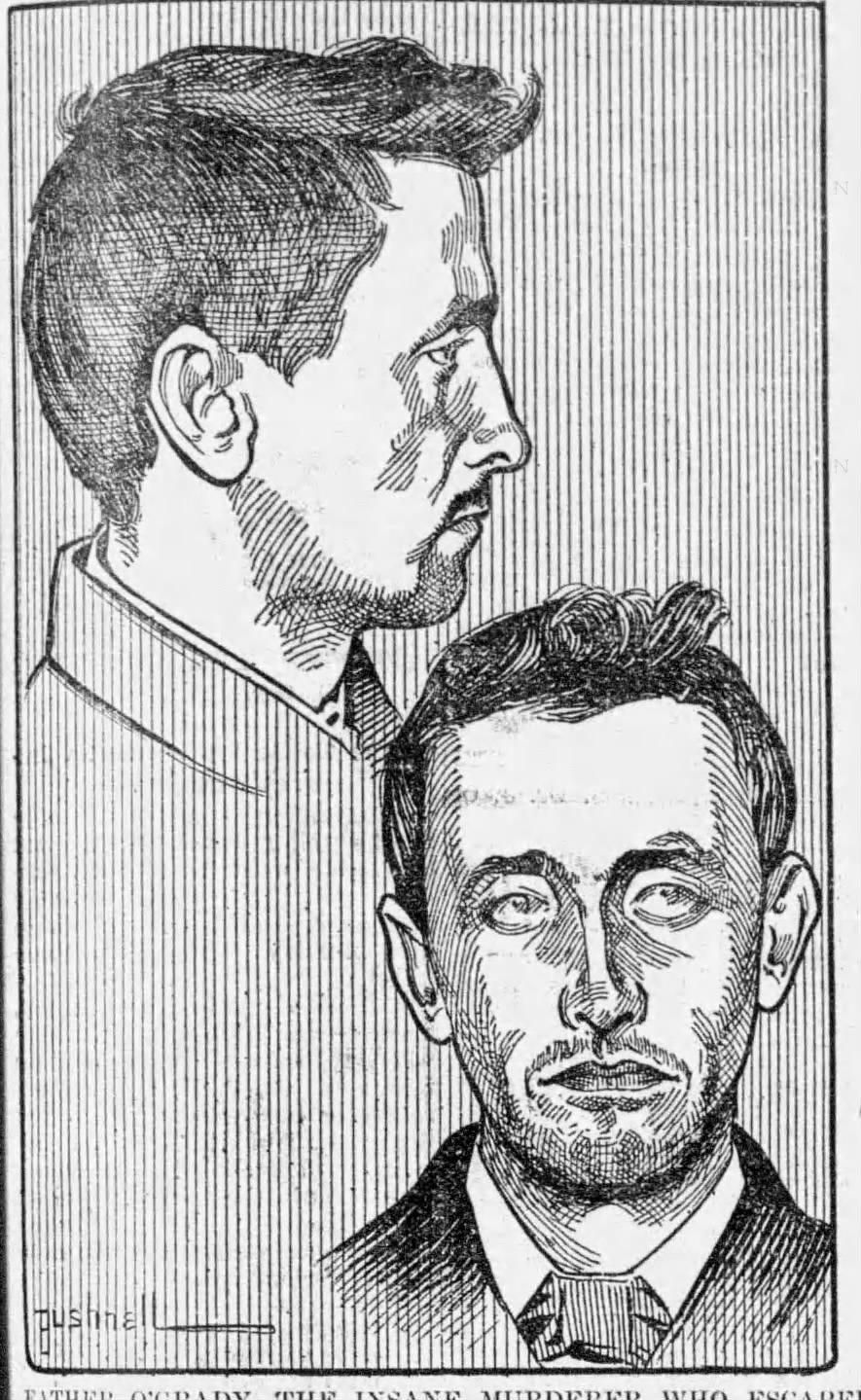Discovering the whereabouts of Fr. O'Grady
Fr. Dominick O'Grady and Mollie Gilmartin: A Revisit, Pt. 2
After reading Part 3 of the story of Mollie Gilmartin and Fr. O’Grady, it seemed that Fr. O’Grady had disappeared. A Silent Sod reader posed a great question: what ended up happening to O’Grady after the murder? I was able to do some digging for this post and will share with you the conclusion of his life.

By comparing two different newspaper articles written after Mollie’s death about Fr. O’Grady and an obituary from Sligo, Ireland, for a Fr. Dominick O’Grady, I was able to determine that Fr. O’Grady was born in 1862 in Sligo, Ireland, and died in 1918 in Sligo, Ireland. Fr. O’Grady’s father, Michael, was a farmer and had seven children of whom Fr. O’Grady was the eldest. Of Fr. O’Grady and his siblings, five were priests and one a nun.1
Fr. O’Grady had been ordained into the priesthood after studying for ten years. He had been in a position that was described as a romantic spot located within a mile of his ancestral home when he was transferred to another location on account of the fact that another priest, Fr. Doyle, had developed romantic feelings toward Mollie Gilmartin. O’Grady then himself developed an “extraordinary fondness for the society of the girl.”2
According to an article in the Evening Herald of Dublin, Ireland, Fr. O’Grady had been willing after the murder to open up to a reporter of the Commercial Gazette of Cincinnati, Ohio:
“She and I have been on intimate terms and sustained intimate relations for nine months. I never shot a revolver before, and did not know what had occurred, when I pulled the trigger of the revolver, a self acting one, this morning. The smoke blinded me, and I continued to discharge the revolver.
“A minute before she had told me that she would sooner be dead than alive, and we both, at different times, had talked of suicide.
‘The last time I saw her was the week before Easter. I called myself George Reid, at her own suggestion, she fearing that her brothers would detect us, and I was introduced to Mrs. Tibbles by that name, she not knowing my true identity. I have also been in the habit of taking drugs to allow me to sleep, and I’m troubled with insomnia. I can tell you that I have not slept five minutes in the last three days.
“When I met her at Springfield, Mass, we went to Buffalo, where we stopped at the Windsor Hotel, kept by Mr Jocelyn, and we were known as Mr and Mrs Brennan. In Detroit we separated, she living with the Sisters of a Convent there, and I went to the Western Hotel. After waiting a week or ten days we went to Toledo, remaining there a short time and then going to Chicago. Her brother sternly objected because we had travelled together, and begged her to go home. I, too, had come to think by this time that matters were becoming serious, and I advised her to do likewise, as I feared her brother would learn of our relations and murder both of us. I then spoke of going West, where I expected to secure a mission. She volunteered to go with me there, and try to secure work with some family, so that she could be near me. My conscience also had begun to prick me most severely. When I went to Dublin with her before she left Ireland, it caused comment, and she knew that I could not return home as long as she refused to deny that we had eloped.”3
After O’Grady’s escape from Longview Asylum in 1899, five years after the murder and prior to the murder trial, he disappeared from Cincinnati, Ohio. Through some genealogical sleuthing, I discovered that O’Grady, in the census of 1901 and 1911, was listed as a clergyman living with two servants in Sligo, Ireland. He continued to live and hold a position as clergyman until 1918 when he died after a short illness.4 On the epitaph of his grave in Ireland it states:
“Pray for the Soul of Very Rev. D. J. O’Grady, P.P., Buninadden, who died greatly lamented, October 2, 1918, aged 57 years, R.I.P, erected by his sorrowing parishioners and friends.”5
It appears that after the affair with Mollie as well as his murdering her Fr. O’Grady was able to return to Ireland to live a life where he was seemingly considered an innocent man and eligible for a clergy position.
Do you believe his assertion that Mollie wanted to die with him at the time of the murder considering the fact that Fr. O’Grady did himself attempt suicide at the police headquarters? Or, did he simply use this excuse to avert responsibility for his actions?
“Love and Crime: Pretty Sligo Girl Murdered by a Priest,” Evening Herald, May 12, 1894, Page 5.
“Love and Crime: Pretty Sligo Girl Murdered by a Priest,” Evening Herald, May 12, 1894, Page 5.
“Love and Crime: Pretty Sligo Girl Murdered by a Priest,” Evening Herald, May 12, 1894, Page 5.
“Deaths,” Irish Independent, October 3, 1918, Page 1.






That’s quite story. It’s also fascinating that every sibling he had was also in the clergy. Makes me wonder what life was like in the O’Grady home growing up. Also, his interview with the Cinny Gazette is very puzzling.
I don’t know what to think about him. Wait yes I do. He never accepted or admitted that he decided to murder her in cold blood.
We only have his words as to what Mollie said.
I don’t believe him that he wanted to follow her in death or he would have at the first opportune chance to do so.
He was the one carrying a gun not Mollie.
This was a great read Charlotte!!!